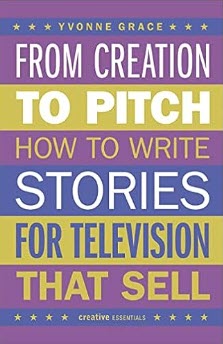Creating a cohesive, engaging, comprehensive, creative and commercial world for television from scratch, getting it out of your head, on to the page/screen and ultimately across the desk of people who can produce and distribute it to the world is a huge, daunting task. But we are writers and pitching for television is the stuff we do. I am also a producer, so I come at this problem – the problem of Pitching – with a sort of scissor action.
The writer ‘voice’ needs to be strong in your pitch and reflected in the visual, entertaining pages of your treatment or pitch deck. But also just as as strongly, the marketable, commercial aspect of the work you are presenting to the room here; in this white hot moment of the creative sell, needs to be clearly heard.
Pitching in essence, is a conversation. That’s all. A mild, easy concept to wrap your head around. Most writers, by definition, are solitary animals and tend to spend a huge amount of time on their own, wrangling with the blank screen, scribbling in note books, looking out of the window and talking to themselves. So when it comes for them to be required to be in a room of busy, often time strapped industry folk, who frankly have all been there and done this a thousand times, to pitch the world of story and character they have been struggling with for months, it often appears as a horrible and unappealing task. That’s why thinking of The Pitch in more gentle terms as A Conversation often takes the initial sting out of this inevitable event.

You want this to happen. Right? Why else would you spend so much of your waking hours writing this story across a protracted length of time; drilling into the world of your characters, living with them for months on end, mapping and remapping their trajectory and always thinking of your audience – what do you really want to say and how are you going to say it so they want to watch and resonate with it? So getting to this point, to the point where you feel ready to pitch this world to those that have the power to make it happen, is a really good thing. But it’s not as simple as that. Of course it’s not. Anything worth having; any achievement, any credit, any accolade, is really only worth it if there has been effort, some semblance of striving, personal growth and learning in there somewhere. I find writing is the perfect storm of all of these things. So when you get to the most exposing level in this, your own personal Development Hell, every fibre of your being is pulled tight at the thought that you might, just might, mess this up.
Stop. No negativity here. Yes, there may be an inner voice saying you shouldn’t be in this room, the idea you have is not going to cut it, your choice of outfit was a big mistake, but this is just your insecurity talking and we all have that, to a greater or lesser extent. There needs to be always a voice that measures, analyses, questions and tests the creative decisions you make as you build this story world which you ultimately will be presenting to the industry. The question here is when to give that voice the floor and when to tell it to shut up. For once you are in the room and you have the floor, then is the time to engage the voice that says ‘this is exactly the right time and this is exactly the right project and I am the person to tell them this’.
As well as the work itself, the problems that need fixing, the message that needs honing, working with writers, I find the question of self confidence and when to really let that shine out, is part of the territory I cover via my consultancy work with writers .
The Visual and the Question
Television is a visual medium so always lead with that idea as you begin your Pitch. Taking the visuals that inspired you possibly to start the project in the first place, or the image that frames the opening of your Pilot, or that you used in the construction of your Treatment now use this to draw in and engage your audience by the power of your visual imagination. And here, you may ask a question – what would happen if….?
Characters
Expanding on the question you ask, you will find that you are able to drill into the actual body of your story line via the character/s that you have constructed this narrative around. These are the narrative drivers and you need to focus on these characters to give your pitch relevance and an emotional engagement from your listeners. Your piece may be high concept, it may be political, it may be in essence an exploration of global warming and climate change, but ultimately it is populated by people; characters that introduce, expand and deliver your message on the themes you wish to explore. Make it all personal. Make the issue, the politics, the bigger picture, personal, concise, immediately relatable. Do this via character.
Pace
Don’t meander. Don’t procrastinate. Don’t lose momentum. Definitely set up an easy, conversational rhythm (I was once pitched to by an enthusiastic, but obviously nervous writer who as a result literally shouted at me for the duration of his pitch – exhausting for him and me) and keep it that way. Give the impression that you are literally chatting. It’s hard, I know to do this but if you warm to your story, via your characters, if you remember why you love this project and let this shine through, trust me, what you say will land. I have yet to meet a producer who doesn’t respond in some way positively to a pitch that is delivered by a writer who clearly loves their job and their project.
Shape
There’s got to be a structure to your pitch. The beginning, the middle and the end – this of course, we know. As all good television writers understand, structure is essential to the creation of a strong series, but it has to be invisible to the audience. We know where the joins are and how this world is constructed, but the joinery is invisible when we allow the narrative to flow from it and so audience engagement happens.
Use this thinking in your pitch. Sell ‘the sizzle not the sausage’. By this I mean don’t go into detail, describing each plot beat in the story as you know it. This is oxygen stealing in a pitch. No one wants to learn every twist and turn. We do want to get a sense of how twisty this is, by the choices you make in terms of what you describe and what you miss out.
There needs to be a shape to your pitch. A form that is easily followed by the room. A sense or introduction, an expansion and a landing where by we come to realise the essence of what it is the series is about and how you intend to explore this. The over all impression having delivered your pitch, ideally will be one of some detail, strong visuals, a sense of place, time and people and ultimately a message. Let the shape be contained, solid, framed by visuals and character, not a meandering stream of thought and ideas that don’t connect or land.
There’s more. Pitching is a huge area to explore. There’s a solid chapter about Pitching and how I recommend writers approach it, in my second book (the Purple One following on from the Green One) From Creation to Pitch which you can buy from my website and I really hope it helps you get your ideas out to industry. Producers and Broadcasters need you.
Get in touch if you want me to help you get your projects market ready.

